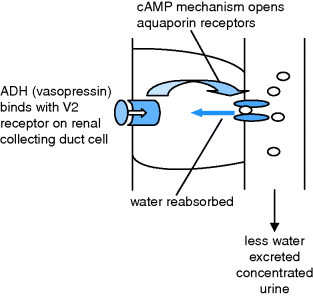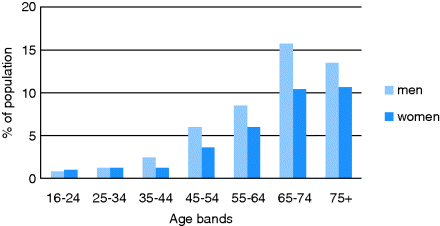Age Changes
There is a reduction in lean body mass and body water and a relative increase in fat. When marked this is known as sarcopaenia and constitutes a marker of physical frailty. It is gaining acceptance as a geriatric syndrome.
Endocrine Changes
Some elderly people have immeasurably low levels of growth hormone; in some, it fails to respond to an insulin tolerance test. Some male subjects have global muscle wasting, and the administration of human growth hormone has been shown to increase lean body mass and reduce adipose tissue but without clear benefit to quality of life.
Other Hormonal Changes
- Serum noradrenaline ↑ (but β-receptors ↓).
- Insulin ↑ (due to insulin resistance): carbohydrate tolerance diminishes.
- Arginine vasopressin (AVP) ↓ susceptibility to hyponatraemia ↑.
- Atrial natriuretic peptide ↑ and nocturia ↑.
- Oestrogen and progesterone in women ↓, follicle stimulating hormone (FSH) and luteinizing hormone (LH) ↑.
- Testosterone in men ↓, FSH and LH ↑.
- Renin and aldosterone ↓.
Adenomas are common in anterior pituitary, thyroid and adrenal glands and are usually of no clinical significance.
Fluid and Electrolyte Imbalance
Acutely unwell elderly patients are very often fluid-depleted or fluid-overloaded, and occasionally both.
Reasons for Vulnerability to Dehydration
- Impaired thirst response.
- Dementia or depression.
- Immobility.
- Reluctance through fear of being ‘caught short’.
- Swallowing difficulty.
- Acute illness.
- Reduced concentrating ability by kidney.
- Diuretics.
- Diabetes, diarrhoea and vomiting.
Salt and water loss are often replaced by water, tea, etc. Mixed salt and water depletion presents with confusion, weakness, reduced turgor, tachycardia and postural hypotension, as the extracellular compartment is mainly affected.
Hyponatraemia
This is common and is due to too little sodium, too much water or both. Do not treat the sodium level in isolation. If the result is very odd was it taken from a drip arm? Depending on the assay, high lipids and high protein in myeloma can give false results. Decide whether the patient is dehydrated, euvolaemic or fluid overloaded. The most accurate clinical finding in dehydration is postural hypotension.
- If the patient is dry, salt and water have been lost either through the kidneys (diuretics especially thiazides, renal failure, osmotic diuresis), the gut (vomiting, diarrhoea, fistula, adenoma) or skin (burns).
- If the patient is oedematous, there is relative water excess due to fluid retention (in cardiac failure, liver failure or nephrotic syndrome) or excess water intake (usually overenthusiastic dextrose after surgery).
- If the patient appears euvolaemic, one of the preceding may be developing. However, if the urine is concentrated when it should not be (sodium > 20 mmol/L in the presence of hyponatraemia) and the plasma is dilute with a low plasma osmolality (< 260 mmol/kg), this is the syndrome of inappropriate antidiuretic hormone (SIADH). Accumulation of intracellular water in the brain causes confusion, headache, lethargy, coma and fits. The level of sodium and the rate at which it falls are important: if it happens slowly brain cells have time to adapt to extracellular hypotonicity. Similarly, rapid correction may lead to the irreversible osmotic demyelination syndrome: paresis, dysphagia, dysarthria, diplopia and loss of consciousness. In frail older people aim to correct by no more than 8 mmol/L/24 h.
The mechanism by which ADH affects water reabsorption in the renal collecting ducts is shown in Figure 12.1.
Hypernatraemia
This is usually due to water loss in excess of sodium loss and occurs where patients are unable to take in enough water to meet their needs.
Oedema
If oedema is present to knee level in a patient in a chair, slip a hand under the thigh and, if oedema is present there too, lean the patient forward to check for a sacral pad. Not all leg swelling is oedema and not all oedema is due to heart failure.
Hypokalaemia
Low potassium (K) is common in elderly patients, often due to diuretics or GI loss (remember the laxative abuser), exacerbated by inadequate dietary intake (deficient in fruit, vegetables and meat). Mild Conn’s syndrome is probably under-recognized. It has been reported that sick elderly females, in particular, may develop ‘acute transient hypokalaemia’, probably due to a shift into the cells, which usually self-corrects within a few days. Hypokalaemia exacerbates digoxin toxicity. Replace orally or by slow intravenous infusion if severe. If the response is poor, check for low magnesium, as correcting this helps.
Hyperkalaemia
This occurs in renal failure and rhabdomyolysis (which may follow a collapse and long lie). However, drugs are the common culprits. In old age, cardiac failure can often be managed with furosemide alone without needing the addition of potassium-retaining amiloride. A combination of an ACE inhibitor and spironolactone may be evidence-based treatment for cardiac failure, but, particularly if co-amilofruse is also prescribed, will usually result in dangerous hyperkalaemia with older kidneys!
If the ECG is abnormal give intravenous calcium gluconate first, then insulin and glucose. Low dose oral calcium resonium can be useful in the long term, e.g. if the patient is not suitable for dialysis, and is more palatable than a low K diet. Doses of ACE inhibitor, ARB and potassium-sparing diuretic that control heart failure when the patient is well, may in hyperkalaemia and renal failure in an intercurrent illness causing dehydration. On admission, hold the next dose of such drugs until you have confirmed that the creatinine and electrolytes are acceptable. Omit if BP is low or may drop, e.g. if surgery for hip fracture is planned or the patient develops diarrhoea. If the drugs are restarted teach ‘sick-day’ rules: omit the drug if vomiting or diarrhoea develops.
Diabetes Mellitus
Definition
Diabetes mellitus (DM) is a metabolic disorder with heterogeneous aetiologies characterized by chronic hyperglycaemia and disturbances of carbohydrate, fat and protein metabolism resulting from defects in insulin secretion, insulin action or both.
The WHO Diabetes Programme (2011) recommends an HbA1c cut-off of 6.5% (48 mmol/mol) for diagnosis of diabetes.
- Advantages: reflects average glucose over 8–12 weeks, avoids day to day variability; test can be done at any time of day without fasting or a glucose load.
- Disadvantages: assays may lack standardization, affected by anaemia, haemoglobinopathies, red cell turnover, e.g. malaria and renal failure.
- Effect on incidence: this criterion alone will identify fewer ‘diabetics’ than the old criteria, but as it is more convenient more people may be tested.
The old WHO criteria (1999) remain valid and can be used in parallel; the ranges of blood glucose indicative of DM are:
- Random venous plasma glucose ≥ 11.1 mmol/L or
- Fasting plasma glucose ≥ 7.0 mmol/L or
- Plasma glucose ≥ 11.1 mmol/L at 2 h after a 75-g oral glucose load (oral glucose tolerance test).
Epidemiology
Prevalence rises with age up to the highest age band studied (84 years) and is higher in AfroCaribbean and South Asian people than white people in the UK. Since 1996 the number of people diagnosed with diabetes has increased from 1.4 million to 2.6 million. By 2025 it is estimated that over 4 million people will have diabetes because of our ageing population and increasing numbers of obese people; 90% of adults with DM have Type 2. Half the diabetic population and a quarter of insulin users are elderly. A common ‘ballpark’ figure is that over 10% of people aged 70 have known diabetes and the same number have unrecognized impaired glucose tolerance. In care homes around a quarter of residents have diabetes. Figure 12.2 shows the effect of age on the prevalence of diabetes in England.
Stay updated, free articles. Join our Telegram channel

Full access? Get Clinical Tree




